
FORT LAUDERDALE, Fla. (February 26, 2010) - "How should an Army and the Soldiers within it-whether they're enlisted, officer, warrant or civilian-learn in a continuum from the time they're assessed to the time they retire'"
That was a question posed by Gen. Martin Dempsey during a panel discussion held at the Association of the United States Army's Winter Symposium and Exposition held here yesterday.
Dempsey, commander of the Army's Training and Doctrine Command (TRADOC), participated in the panel discussion along with other training professionals representing not only TRADOC, but other organizations including the Army G-3/5/7, U.S. Army Forces Command (FORSCOM) and U.S. Army Installation Management Command (IMCOM).
"You'll enter this (learning) continuum and sometimes TRADOC will be responsible for your development ... and sometimes Forces Command or the deployed forces will be responsible for development, but it's a shared responsibility," Dempsey said. "But there wasn't much we could do together because you move episodically from the institutional schoolhouse to the unit. Now what we're suggesting is technology actually should, if we leverage it correctly, allow us to share responsibility for learning over the course of a career."
The TRADOC commander was referring to an Enterprise Approach to Support Training of a 21st Century Army, which was the theme of the panel discussion. The Enterprise Approach empowers leaders to take a holistic view of organizational objectives and processes in order to act cohesively for the good of the entire organization and to achieve outputs with greater efficiency.
Dempsey was also referred to the Army Training Concept (ATC). This "Campaign of Learning" requires new ideas and methods for professional military education. The ATC reflects an understanding that new Soldiers and Army civilians learn differently than those of previous generations and that the Army's methods must adjust accordingly in order to continue developing world-class Soldiers, civilian employees and leaders.
The ATC also aims to make this continuum of learning less location dependant and more mobile, a point echoed by Col. Paul Funk, deputy commander, U.S. Army Combined Arms Center -Training. "Future training support ... it's really a thought process that brings the training resources to the Soldier, not the other way around. So that's one of the things we're trying to do as we build the Army Training Concept from 2012 to 2020," Funk said.
Funk emphasized that "the Army Training Concept will take input from a variety of sources (a tenant of the Enterprise Approach) including the Army Training Strategy, Army Training Concept, Training and Leader Development guidance, all of the enablers, the framework of training and education, the central "Training Brain" and then drop all these inputs into the process so we get the right mix of enablers - live, virtual, constructive, gaming technologies - all put together so we can do training anywhere in the world, with any unit in the world, and provide ourselves trained and ready forces." (A primary goal of Army Force Generation (ARFORGEN)).
Jim Slavin, Director of the Joint Training Counter-Improvised Explosive Device Operations Integration Center (JTCOIC) expanded on this notion of a Training Brain. "We wanted to take advantage of the relationships we have with FORSCOM, TRADOC, the Joint IED Defeat Organization (JIEDDO), the other (military) services, and take advantage of the data down range and apply it to pre-deploying operations or training. Pulling the data back and doing different things with it to provide reality and enable the training to be more representative of the operational environment."
The Training Brain was a proof of concept initiative that was done in conjunction with the combat training centers (CTC). The JTCOIC wanted to enhance the data used at the CTCs. It did so by bring data back from the theaters of operation and applying it to training scenarios. "So now you have to deal with the things you will face in theater," Slavin said.
"Normally during a CTC training rotation there would be about five different sources of data that would drive the scenario and about 250,000 messages that you would have to deal with. Now by grabbing the data from the operational environment we've brought that up to about 50 different data bases and up to 2.5 million records. Now the staff, the operators, are getting a work out that will closely replicate what's going on in theater." These realistic scenarios and information contained in these enhanced data bases are also being tapped to train Soldiers at all of TRADOC's Centers of Excellence.
The Army Training Concept calls for integrating digital platforms with traditional methods of learning into a blended learning environment. Both military and corporate organizations have demonstrated that these blended learning environments enhance performance and information retention.
The JTCOIC also uses digital platforms to enhance training. For example, the JTCOIC can take an IED event that happened today and, using modeling and simulation, replicate that event over a period of just four days. These products are pushed to units getting ready to deploy to Iraq and Afghanistan, and to the Centers of Excellence, so Soldiers and leaders are aware of current enemy tactics, techniques and procedures and can better train to identify and defeat the IED threat.
Another application the JTCOIC is exploring is the immersive environment. Slavin explained that you can put Soldiers inside an environment about the size of a basketball court, and using geo-typical or geo-specific digital scenarios, replicate the operating environment Soldiers and units will soon face.
Slavin mentioned that JTCOIC is also looking at the benefit offered through massive multi -player online gaming (MMOG). "Your kids are doing that today, my kids are doing that today, interacting in a game-like capability with kids all over the country, all over the world, so why can't we train that way' Again, you put an operational environment over that and deal in a game that is self learning so every time you come in and want to train with somebody it may not be at your post, camp or station, or at your particular center of excellence, but you interact via this MMOG in an operational environment that is real, not a game. The bottom line is how do you take this operational environment, enable the training, so that we really can make the scrimmage as tough as the game."
Gen. Dempsey concluded panel discussion by reminding the audience that "the challenge we face is that we have to get ready for an Army that will have a potentially insatiable demand to train and to expand the aperture away from strictly [counterinsurgency] to hybrid threats, full-spectrum operations, maneuver training, and all the things that we know can atrophy over time. I'm more worried about challenging [Soldiers] than I am about finding them unready ready for the challenge. But we have to get ready."
Related Links:
TRADOC News Service: Dempsey talks TRADOC future, leader development at AUSA

Social Sharing